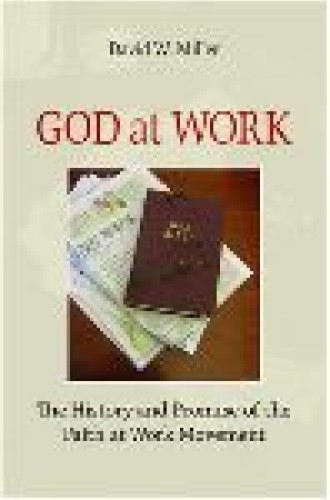God at Work
Some books simply cannot be written because the subjects are too large. Who could read a history of Fridays? One particular long-ago Friday, of course, is another matter. David Miller’s book takes an enormous subject—faith in the workplace—and narrows it down to a phenomenon of recent decades, a lay-led revival called “Faith at Work.” And by focusing on this movement, he raises surprisingly large questions.
What is the nature of worship, for example? Must it be confined to a sanctuary? What is the ministry of the laity, and can it be found only in a church? How should Christians deal with the taboos against religion in public spheres?
A former financier, Miller has a personal grievance. He believes that the church has undervalued the work of laypeople, that it uses them merely as volunteer help for professional clergy and ignores what they do for a living. Capitalists, he says, are often treated with contempt and hostility in churches. Meanwhile, a profound lay movement has arisen in the places where people spend most of their week and find most of their identity. In this movement, Miller believes, God is at work; hence his book’s title.
Since leaving his “dream job” in high finance to attend seminary, Miller has tried to connect those worlds. Similarly, the Faith at Work movement, he says, is “a quest for integration.”
Businesspeople want the ability to bring their whole selves to work—mind, body, and soul—and are no longer satisfied with sacrificing their core identities. . . . People in the workplace of all levels and types no longer seem willing to leave their soul with the car in the parking lot.
In recent years, as Christians have started workplace prayer groups, Bible studies, newsletters and online chat groups, they have built what pastors only dream about—a church without walls.
This modern quest for meaning finds its antecedent in the Hebrew word avodah, which unites work and worship. Avodah suggests that any honest labor is as high a calling as ordained ministry. Miller cites Elton Trueblood’s observation: “Most men ought to stay where they are and to make their Christian witness in ordinary work rather than beyond it.”
As an argument for a broader concept of lay ministry, Miller’s book is persuasive. As a history of a movement, though, it rambles. He hauls in plenty of material from business literature (almost all drawn from upper management rather than the factory floor), but he doesn’t quite connect the far-flung examples. The “first wave” of the modern movement he identifies with the Social Gospel, but he admits that it influenced mostly clergy. A “second wave,” belonging to laypeople, mostly men, established groups like the Full Gospel Business Men’s Fellowship and a magazine called Faith at Work. It’s not entirely clear how these efforts aimed at the upper echelon gave rise to the scattered, autonomous and theologically diverse groups of today.
Miller does a better job of describing the challenges and moral dilemmas these groups face. Many Americans feel nervous when Christianity wanders from its pen, as if it were a lamb in a china shop. Not everyone welcomes proselytizers in the office.
Yet as Miller notes, this is not a homogeneous movement, and not all Faith at Work groups are evangelistic. Some prefer to integrate business with ethics or discuss how they experience work in spiritual terms or take up spiritual exercises for personal enrichment. Miller has combined these four Es (evangelism, ethics, experience and enrichment) into an “integration box” that describes the groups with considerable subtlety. Apparently he is not the only scholar on that job, but he laments that Faith at Work has gone all but unnoticed by seminaries.
Should this book survive to a second edition (or a fourth wave), I trust that an editor will prune away the redundancies that pad even its slender 232 pages. And something is missing—a theologian’s skepticism. Miller set out to write a history rather than a biblical reflection, but I still regret the lack of more scriptural underpinning. It would have been worthwhile to contrast today’s ambitious careerists with the more sardonic author of Ecclesiastes. Miller might have explored Jesus’ attitude toward labor (“Consider the lilies, how they grow; they neither toil nor spin”). For more than 100 years, a certain kind of popular literature has portrayed Jesus as the ultimate salesperson or CEO. Despite the Faith at Work movement’s uncritical celebration of work, it seems to me that the Hebrew Bible and the New Testament are shot through with a radical ambivalence about it.
That ambivalence may shed some light on the supposed divide between laity and clergy. It may be true, as Miller charges, that pastors are largely ignorant about business. Most that I know, however, would not be threatened in the least by this movement but would embrace it enthusiastically. What no Christian can quite get past is the divine tension between work and Sabbath—both very much ordained by God, with Sabbath the loser in the modern world. And then there is the outright conflict between God and mammon.
Miller is absolutely right that churches have failed to connect with the largest part of a believer’s week. Too few pastors get to know parishioners in their workplaces or address workplace concerns during worship on Sunday—or bless that work as readily as they do, say, Sunday school teaching. The result is that laypeople can feel radically divorced from these strange church CEOs in robes.
For that message alone, this book deserves to be read. When faith becomes compartmentalized, it no longer is vital. Christians proclaim an incarnational story, telling about God’s work in the world through a carpenter who left his trade and did his greatest work on one particular Friday. If Miller’s book helps his readers to integrate Sunday with Monday, then he will have done his job.





